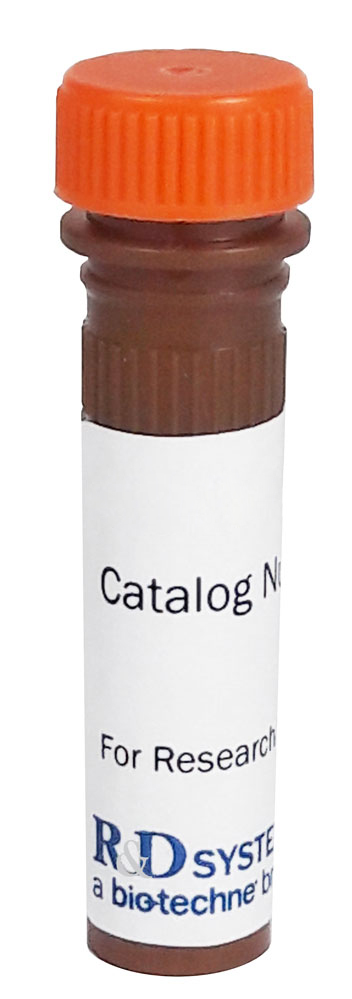Mouse PD-1 Alexa Fluor® 350-conjugated Antibody Summary
Met1-Gln167
Accession # Q02242
Applications
Please Note: Optimal dilutions should be determined by each laboratory for each application. General Protocols are available in the Technical Information section on our website.
Reconstitution Calculator
Preparation and Storage
- 12 months from date of receipt, 2 to 8 °C as supplied.
Background: PD-1
Programmed Death-1 (PD-1) is a type I transmembrane protein belonging to the CD28/CTLA-4 family of immunoreceptors that mediate signals for regulating immune responses (1). Other members of this family include CD28, CTLA-4, and ICOS (2-4). PD-1 is most closely related to CTLA-4 and shares approximately 24% amino acid (aa) sequence identity. The mouse PD-1 gene encodes a 288 aa protein with a putative 20 aa signal peptide, a 149 aa extracellular region with one immunoglobulin-like V-type domain, a 21 aa transmembrane domain, and a 98 aa cytoplasmic region. The cytoplasmic tail contains two tyrosine residues that form the immunoreceptor tyrosine-based inhibitory motif (ITIM) and immunoreceptor tyrosine-based switch motif (ITSM) that are important in mediating PD-1 signaling. Mouse and human PD-1 share approximately 69% aa sequence identity. Two B7 family proteins, PD-L1 (also called B7-H1) and PD-L2, have been identified as PD-1 ligands (5, 6). PD-1 is expressed on activated T cells, B cells, myeloid cells, and on a subset of thymocytes. PD-1 deficient mice have a defect in peripheral tolerance and spontaneously develop autoimmune diseases. Binding of PD-1 to PD-L1 or PD-L2 results in the inhibition of TCR-mediated proliferation and cytokine production as well as BCR-mediated signaling. PD-1 likely has an inhibitory role in regulating immune responses (1-4).
- Ishida, Y. et al. (1992) EMBO J. 11:3887.
- Sharpe, A.H. and G.J. Freeman (2002) Nat. Rev. Immunol. 2:116.
- Coyle, A. and J. Gutierrez-Ramos (2001) Nat. Immunol. 2:203.
- Nishimura, H. and T. Honjo (2001) Trends Immunol. 22:265.
- Latchman Y. et al. (2001) Nat. Immun. 2:261.
- Tamura, H. et al. (2001) Blood 97:1809.
Product Datasheets
Product Specific Notices
This product is provided under an agreement between Life Technologies Corporation and R&D Systems, Inc, and the manufacture, use, sale or import of this product is subject to one or more US patents and corresponding non-US equivalents, owned by Life Technologies Corporation and its affiliates. The purchase of this product conveys to the buyer the non-transferable right to use the purchased amount of the product and components of the product only in research conducted by the buyer (whether the buyer is an academic or for-profit entity). The sale of this product is expressly conditioned on the buyer not using the product or its components (1) in manufacturing; (2) to provide a service, information, or data to an unaffiliated third party for payment; (3) for therapeutic, diagnostic or prophylactic purposes; (4) to resell, sell, or otherwise transfer this product or its components to any third party, or for any other commercial purpose. Life Technologies Corporation will not assert a claim against the buyer of the infringement of the above patents based on the manufacture, use or sale of a commercial product developed in research by the buyer in which this product or its components was employed, provided that neither this product nor any of its components was used in the manufacture of such product. For information on purchasing a license to this product for purposes other than research, contact Life Technologies Corporation, Cell Analysis Business Unit, Business Development, 29851 Willow Creek Road, Eugene, OR 97402, Tel: (541) 465-8300. Fax: (541) 335-0354.
FAQs
No product specific FAQs exist for this product, however you may
View all Antibody FAQsReviews for Mouse PD-1 Alexa Fluor® 350-conjugated Antibody
There are currently no reviews for this product. Be the first to review Mouse PD-1 Alexa Fluor® 350-conjugated Antibody and earn rewards!
Have you used Mouse PD-1 Alexa Fluor® 350-conjugated Antibody?
Submit a review and receive an Amazon gift card.
$25/€18/£15/$25CAN/¥75 Yuan/¥2500 Yen for a review with an image
$10/€7/£6/$10 CAD/¥70 Yuan/¥1110 Yen for a review without an image


